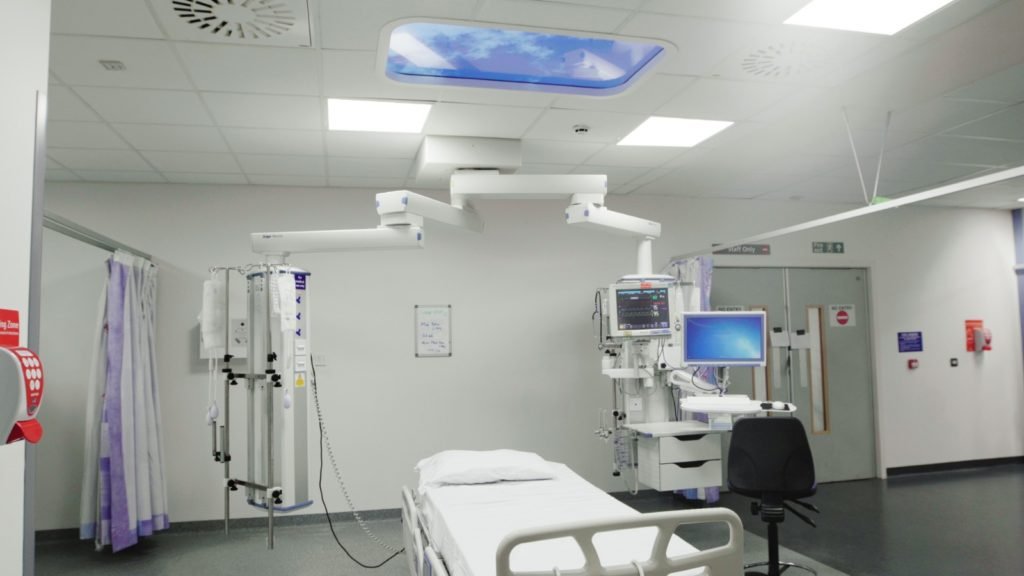Bringing More Humanity Into EDs And Intensive Care
Winter sky and frosty twigs scene
How Human-Centric Lighting Can Improve Stressful Environments
Intensive care units, emergency departments and other highly stressful healthcare environments are not the nicest of places to be in. Especially for people experiencing a critical medical situation.
Staff work tirelessly to provide the most comfortable and effective treatment for patients within these environments. But as most departments are designed for practicality, interiors can often feel overly clinical. By bringing more of a gentle touch of humanity into these spaces, we can help improve the experience. Not just for patients, but for staff as well.
More Than Dimmable Lights
Human-centric lighting can go a long way in improving the overall experience in these environments. As the term suggests, it is artificial lighting that’s designed around a person’s needs.
It can help people stay connected to the natural day’s cycle. For example, through differing warm and cool colour lighting to mimic the day from dawn to dusk. Also by following the sun’s yearly progression through winter, spring, summer and autumn.
This reduces the harsh, white light prevalent in hospitals that can have a detrimental effect on patients and staff. In addition, as it emulates the daylight outside, it promotes healthy sleeping patterns. This is because we need daylight exposure for our bodies to release the natural sleep hormone melatonin.
Resetting Patients’ Circadian Rhythms
Our Living Sky circadian rhythm systems are designed to assist treatment and healing within the healthcare environment. They make a big impact in rooms or wards with little access to natural daylight. Or, ones lit by overly bright, unnatural lights well into the evening.
The systems feature soft, natural imagery, such as peaceful seascapes and forest scenes. This also helps patients engage with calmer, less clinical environments. They’re especially beneficial in examination, procedure, and holding bays, as the visuals and lighting combined help reduce anxiety, stress, and trepidation.
Calming sea and distant land scene
Living Skies are pre-programmed to emulate the day’s natural cycle by following through from sunrise to sunset and into nighttime sequences. As a result, they encourage healthy sleeping patterns and allow patients’ body clocks, or circadian rhythms, to reset.
Resetting these important patterns can help reduce symptoms of delirium. About 2 in every 10 hospital patients experience delirium (Royal College of Psychiatrists). It’s more likely to be experienced by those in intensive care. Delirium can slow down recovery and even increase the risks of dementia and death.
Empowering Healthcare Staff Across The UK
We’re proud to be supporting hospitals where staff are making use of these new technologies within ICUs and other critical care environments. HDR, ED, CCU, HDR and long-term stay departments also benefit from the effects of our circadian rhythm and human-centric systems.
Arrowe Park Hospital, part of the Wirral Teaching Hospital NHS Foundation Trust, is currently installing brand new circadian rhythm systems into its High Dependency Unit’s 6-bed bays.
Example of sky ceiling at Royal Stoke
These Living Sky circadian systems will replicate, in high definition, moving images of the natural world in real-time, and be seasonally correct. They’ll bring the benefits of the outside world indoors by assisting patients’ circadian rhythms to reset. They are adjustable and can cope with differing levels of trauma per patient.
Working Alongside The NHS
Our systems are medically validated by leading neuroscience departments and hospitals throughout the UK. Together we’re working to improve patient wellbeing, reduction in bed stay and, in some cases, lowering the need for ongoing pain medication. To ensure our work is constantly evolving, we always listen to NHS professionals and refine our products so that our designs meet the ever-changing and challenging needs in healthcare.
See our medical testimonial videos to understand how healthcare centres are deploying circadian rhythm systems to complete patient improvement strategies.



